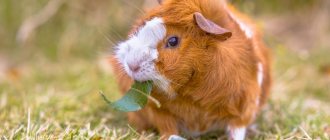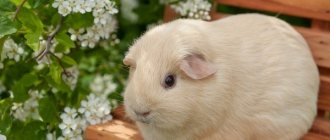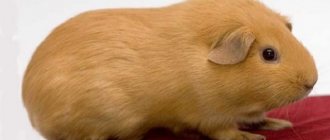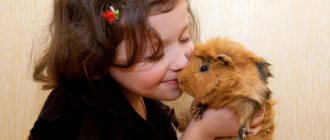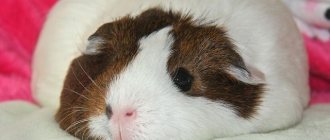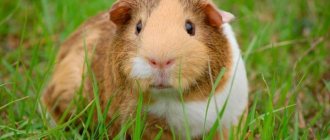The body structure of decorative cavy differs from its wild counterparts in the width and roundness of its shape. The normal weight of a guinea pig depends on gender and breed. Males are larger than females, by about 20-25%.
The limits to which guinea pigs grow are influenced by genetics and the conditions in which the animal grew up and is kept. Monitoring the dynamics of parameters and comparison with the norm helps to monitor the health of the pet.
Weight and size of guinea pigs
The body structure of decorative cavy differs from its wild counterparts in the width and roundness of its shape. The normal weight of a guinea pig depends on gender and breed. Males are larger than females, by about 20-25%.
The limits to which guinea pigs grow are influenced by genetics and the conditions in which the animal grew up and is kept. Monitoring the dynamics of parameters and comparison with the norm helps to monitor the health of the pet.
What does the size of the animal indicate?
The following factors influence the size of a guinea pig:
Why does the owner need to know the normal size of the pet? First of all, height and weight indicate the health status of the animal. Knowing the normal dimensions of a pig also helps you navigate correctly when buying a pet. Based on this indicator, one can judge the estimated age and purity of the animal’s breed.
Next, we will take a closer look at the factors that influence the height and weight of guinea pigs.
How big does a male guinea pig grow? Adult males can reach a body length of up to 35 cm. They weigh up to 1.5 kg. Mature females are usually much smaller, their height is no more than 25 cm, and their weight rarely exceeds 1 kg.
Periods of growing up
Conventionally, the life of a pig can be divided into 4 stages. The norms for weight and size may differ for different breeds, but for the dynamics of development they are common to all representatives of the species.
The childhood period is characterized by intensive growth. The average weight of a newborn cavia is 50-140 g. The parameters are influenced by the age of the mother, living conditions during pregnancy, and the number of cubs in the litter. Usually the larger animals are those that were born first in the litter.
Baby guinea pigs are born quite large with fur and already with open eyes
How much a particular pig should weigh at 2 weeks can be determined by doubling its weight on the first day.
By the fifth week, the guinea pig's growth reaches 19 centimeters. Age is good for purchasing a pet. By this time, the animals are completely ready to be weaned from their mother.
Girls reach puberty around the 30th day of life, boys around the 70th day. Animals show interest in individuals of the opposite sex and are physically capable of reproducing. The rodent's body is still not fully formed, so mating at such an early age is not recommended.
In adolescence, the animal begins to show interest in the opposite sex. At 3 months, the difference in size between rodents of different sexes becomes clearly pronounced. The weight can exceed that of a newborn piglet by 10 times.
The formation of the body ends by the 6th month. The animal is ready to perform its reproductive function. The growth rate is decreasing.
The rodent becomes an adult at 15 months. Until these years are reached, kavias grow and gain mass. An adult guinea pig should weigh at least 700 g.
The average life expectancy of a pig is 6-8 years. From the age of 4, age-related changes begin in the body. By the age of 6, your guinea pig may begin to lose weight. Reproductive function is disrupted, problems with the absorption of nutrients appear. Aging affects appearance, coat and mobility.
Piglet weight table
The weight of piglets at birth, as well as in the first weeks of life, is determined on portable scales. Further determination is carried out in an evaluative way according to growth change tables.
However, upon reaching a weight of 25-30 kg, it is necessary to separate individuals for herd repair and fattening. The feeding schedule for gilts will be different. This is where measurements come in handy.
By week
The approximate weight of piglets by week of rearing is shown in the table:
Therefore, measurements should be carried out at the 9-10th week of the piglet’s life.
By month
After placement for fattening or raising replacement young stock, selective monitoring of the live weight of gilts is recommended to be carried out monthly.
Visually select at least 5 medium-sized individuals from each cell, take measurements and compare with the approximate growth plan presented in the table:
| Age, months | Live weight, kg |
| 3 | 39 |
| 4 | 45 |
| 5 | 65 |
| 6 | 85 |
| 7 | 110 |
Selling for meat is carried out upon reaching a live weight of 90-110 kg. Further fattening is impractical, since growth occurs due to lard, the market value of which is lower than meat.
At 8-12 months the pig will weigh from 120 to 180 kg.
It will be easy for a farmer to determine how much a newborn piglet weighs using a vag: the baby is placed in a special bag and its weight is measured.
A healthy baby that a sow has just given birth to weighs on average 0.8-1 kg; Vietnamese piglets barely reach 0.5 kg. There are also breeds that can give birth to a baby weighing more than 1.5 kg.
How big does a guinea pig grow?
The table below shows the approximate size of a healthy cavy, according to age. When comparing your pet’s parameters with the norm, you should take into account the specifics of its breed and individual characteristics.
Average table of growth norms
| Age | Body length |
| about weeks | 8-9.5 cm |
| 2 weeks | 10-12 cm |
| 3 weeks | 14-15 cm |
| 5 weeks | 16-20 cm |
| 7 weeks | 21-23 cm |
| 1 year | 24-25 cm |
| 15 months | 27-35 cm |
The record holders for size are rodents of the Kui breed. These guinea pigs grow to sizes 1.5-2 times larger than average: body length up to 50 cm, weight about 4 kg.
The growth of an adult stops at 1.5 years of age. By this age, a guinea pig of most breeds weighs less than 2 kg. Females gain 700-1200 g, and males 1000-1800 g. Body length does not exceed 35 cm.
Guinea pig weight table by month
| Age | Body weight (grams) |
| about weeks | 50-120 |
| 0.5 months | 90-180 |
| 1 month | 145-240 |
| 1.5 months | 200-300 |
| 2 months | 350-400 |
| 3 months | 500-700 |
| 6 months | 650-800 |
| 1 year | 800-1000 |
| 15 months | 900-1500 |
The weight of an adult guinea pig is stable. Sudden changes in parameters are an alarming sign and require consultation with a veterinarian. Regular weighing and monitoring growth dynamics can help identify health problems in your pet in time.
Guinea pigs grow until they are 15 months old; after this age, significant weight gain can be a sign of obesity. The problem usually occurs against the background of a sedentary lifestyle and an imbalance in the diet.
Sudden weight loss can be caused by a lack of nutrients in the diet. The symptom is characteristic of a number of diseases. For some of them, losing weight is the only external sign. A thorough examination will be required to determine the causes.
Natural size of a rodent
In nature, the appearance of wild pigs only vaguely resembles decorative domesticated rodents. Nimble, agile and with a strong muscular body, the animals have been looking for food for centuries and trying to hide from birds of prey and animals, and from people who have discovered the taste of a new type of meat.
Article on the topic: Interesting facts about guinea pigs for children and adults
Despite its light and graceful body structure, the wild pig is hardy and adapted to long runs in search of food . An oblong body with a short neck and legs seems designed to flow among stones and seek shelter in underground tunnels.
Despite the small size and graceful forms of the wild pig, there are real giants among its relatives:
- Moko is a rock pig. It is larger in size than a guinea pig and weighs up to 1 kilogram.
- Agouti - the body of the animal grows up to 50 cm, and weight up to 4 kg.
- Pack - body about 40 cm, weight 10 kg.
- Mara is a rodent belonging to the half-ungulate family. The length of the body reaches 70 centimeters, and the weight is up to 16 kg.
- Pacarana is an animal up to 80 cm long and weighing up to 15 kg.
- The capybara is the largest rodent. The length of the body is 1.3 meters, and the weight is 50 kg .
Since wild animals have been hunted since ancient times, in order to maintain the population, wild species of rodents were forced to interbreed, and there were no purebred pigs left among them. This is confirmed by the range in size of pets, from 15 to 30 cm. Selection has also borne fruit. The domesticated pig lost its tail, but acquired a pleasant rounded shape and relatively larger size than the wild specimen.
Monitoring your guinea pig's weight
Experienced breeders monitor the weight of their young to ensure that the rodent is developing according to normal standards.
Information about the pet's parameters is also useful when the guinea pig becomes an adult. It is advisable to weigh yourself weekly.
In order to find out the weight of a guinea pig, you do not need special instruments. Floor scales are not accurate enough for people; it is better and more convenient to use kitchen scales. The animals tolerate the procedure calmly.
The device will show accurate readings when the pet is motionless. During weighing, you should distract the caviya with a treat or caresses.
Convenient weighing algorithm:
In order not to forget the exact indicators, you can keep a special notebook - a diary. The measurement results should be entered along with the dates. The data will be useful to the veterinarian in case of illness, so it is advisable to take the notebook to the appointment.
Controlling your pet's weight
When breeding guinea pigs, they are regularly weighed to ensure the animals are developing normally. It doesn’t hurt to navigate the parameters even when the rodent has reached adulthood. Every week you need to weigh your pet in order to notice deviations in its development in time.
If your guinea pig begins to lose weight, then you need to reconsider its diet. Most likely, the animal lacks nutrients. Many diseases are characterized by sudden weight loss. Many can manifest themselves outwardly only in this way. In any case, the pet requires qualified help.
Weight control does not require special equipment. Floor scales are also suitable for accurate indicators, but it is much more convenient to perform the procedure using kitchen equipment. Guinea pigs react absolutely calmly to the procedure.
To get accurate results, you need to immobilize the animal. You can try giving your guinea pig a tasty treat or coaxing it with affection.
Sequence of weighing a rodent:
- The pet is placed in a container for convenience;
- The container is sent to the scales, the mass is recorded;
- You need to get the pig and weigh the empty plate;
- You need to subtract the weight of the plate.
It is recommended to keep a record of all parameters in a separate notebook. It is important not only to record measurement data, but also the dates of control weighings. If the animal gets sick, a notebook with such information will be very useful for the veterinarian.
Purchasing a guinea pig requires special responsibility. It is important to remember that we are responsible for those we have tamed. This furball is completely dependent on its owner. That is why it is necessary to properly organize the care of your pet. If you follow all the rules, your guinea pig will live up to 10 years.
What I am a master at is talking incessantly about hamsters. I have three hamsters at home, and my husband has a pet rat. That’s how we live, the six of us eat, the six of us sleep :)
Differences between wild and domestic animals
How big do guinea pigs get in the wild? The largest individuals can grow up to 35 cm. Wild pigs differ in appearance from domesticated pets. Animals living in natural conditions have to get their own food and hide from predators. Therefore, they have a more muscular body and less weight than domestic ones. Wild animals are very hardy and capable of long runs.
For a long time, different types of guinea pigs were crossed. This helped the animals maintain their population in natural conditions. At the same time, large breeds of animals were crossed with small ones. Therefore, the size of domestic guinea pigs can vary from 15 to 30 cm. This largely depends on the size of their wild ancestors. During the selection process, domestic pigs lost their tails. They have a more rounded body than their relatives living in the natural environment.
Historical reference
Guinea pigs have been domesticated for a very long time. The tribes of South America (the territory of Ecuador, Peru, Bolivia and Southern Colombia) ate guinea pigs and bred them for decorative purposes. The selection work carried out at that time made it possible to develop various breeds of guinea pigs, some of these breeds today form the basis of modern domestic guinea pigs.
Traders from Spain and England brought the animals to Europe, where they became popular among the nobility as pets. It is still not fully understood why guinea pigs are called that. It is possible that the body structure of guinea pigs resembles that of pigs. And the sounds made and the fact that the animals constantly eat only add to the similarity. But the guinea pig was named apparently because it was brought “from overseas” and was considered “overseas”.
Currently, throughout almost all of South America, guinea pigs are still eaten. Their meat is considered dietary, and in taste and nutrition it is close to rabbit and chicken meat.
Owner reviews
Of course, the cost of a purebred rare pig is not always affordable for the average buyer, but if you want to engage in professional breeding of such popular rodents, your choice should be on animals with an excellent pedigree.
This is interesting! Pig breeding in our country has not yet reached foreign heights, but already now connoisseurs of decorative rodents are striving to acquire pets with an original and exotic appearance.
Experienced owners are categorically against crossing representatives of long-haired and short-haired breeds, since all the resulting offspring will be classified as low-quality mestizos that do not take part in exhibition shows. Among other things, the inadmissibility of mating representatives of heterogeneous breeds is due to the inhibition of the development of breed qualities.
In any case, the guinea pig is rightfully one of the best pets, especially for anyone who is trying to get an animal for the first time. This animal is unpretentious in care and easy to keep, very affectionate and quite sociable, so it is ideal for home keeping even in families with children.
Return to content
Character of the Abyssinians
It has already been written above that all representatives of the breed are characterized by pugnacity and quarrelsomeness. True, this only applies to those cases when the owners are trying to add new individuals to an already established social group.
The fact is that in the “family” there is a strict hierarchy, where there is a boss (usually a male) and subordinates (females). If you introduce a new member, then a struggle for leadership will naturally begin, which will inevitably lead to fights and a showdown. Both males and females can fight, and the latter fight just as desperately as the stronger sex.
In some cases, it is the males who act as peacemakers, reconciling careless, jealous females among themselves. “Girls” can hate each other, but at the same time behave more or less peacefully, as long as the situation is under the control of the leader.
Therefore, when forming families, you must follow simple rules:
- create families from an early age,
- in any group there should be several females and one male who will regulate relationships,
- never place pregnant females into an established group, otherwise the loss of offspring cannot be avoided,
- To keep several pigs, choose the largest cage possible so that the pets have their own space.
Despite the complexity of relationships between relatives, rosette pigs behave more than ideally with humans. They respect and love the owner as their breadwinner. They are always kind and peaceful with him. There has probably not been a single case of a rodent biting a person at least once.
Moreover, patterned pets not only coexist with people, but are excellent companions and happily communicate with the owner, greeting him with joyful purrs and squeaks.
Stages of life according to human standards
The lifespan of most pets is comparatively shorter than that of a human, so their owners have a completely logical question: how to compare age stages. Considering that most rodents at home do not live more than 8 or 10 years, and also focusing on their condition during this period of time, the ratio of their age to a human will look something like this:
| Person's age | Guinea pig age |
| 6 months | 15 days |
| 12 years | 4 months |
| 23 years old | 15 months |
| 65 years old | 6 years |
| 85 years old | 8 years |
Just like among people, among guinea pigs there are real long-livers, so if a rodent has been living with you for about 15 years, it can be argued that if it were a person, it would have long ago crossed the hundred-year mark of its life.
Breeding
It has already been noted that rosette rodents are the most difficult pets in matters of reproduction. But this does not concern fertility, but is associated with the difficulty of obtaining offspring of the required standard.
Very often, smooth-haired babies are born, which in principle is the norm. But the appearance of cubs with irregular rosettes indicates a non-sterile gene pool, in which the blood of some other breeds is present.
Important! Cannot be crossed with long-haired breeds. Perhaps the first generation will be rosette with a perfect “chessboard”, but the second and subsequent litter will turn out to be terrible with incomprehensible-looking rosettes located in a chaotic order
In addition, long-haired pigs will make the coat silky and overly soft.
Rosette guinea pigs are beautiful in their own way with their ruffles and patterns. They are distinguished by good health, easy to care for and not demanding in maintenance, so they are often considered ideal pets for children and beginners.
Newborns
It is also interesting to know what size a guinea pig should be at birth. The cubs that are born have a height of 5 to 10 cm. In small breeds, the weight usually does not exceed 45–50 g, and in large breeds it reaches 100–120 g.
Much depends on the number of newborns in the litter. The more cubs a female bears, the smaller the size of each of them. Birth order also plays a role. Individuals born first are usually larger than others.
The size of the babies is also affected by the course of pregnancy in the female. If the guinea pig is healthy, then it can bear three large cubs, which at birth will weigh at least 100-120 g.
Cubs are considered newborns under 7 days of age. During this period they practically do not grow.
Breed
The size of guinea pigs largely depends on the breed. During the selection process, individuals of different heights and weights were crossed, so both miniature and large animals are found. The following breeds of domestic guinea pigs have the largest dimensions:
- Abyssinian;
- coronet;
- tortoiseshell;
- English Rex;
- Ridgeback;
- Teddy;
- kui;
- Himalayan;
- Peruvian.
These animals often reach weights of more than 1–1.5 kg.
Factors affecting the height and weight of an adult
The modern guinea pig has generally accepted standards, but its weight and size fluctuate due to a number of reasons.
Newborn pigs
Typically, at birth, the length of a baby pet is about 10 cm
. However, you need to take into account the number of piglets in the litter; the more cubs, the less growth. Length is influenced by priority; as a rule, large piglets are born first. An important factor is the well-being of the female during pregnancy.
A healthy individual is capable of bearing three large cubs weighing from 100 to 120 grams each.
In a couple of months after birth, a piglet can almost double in size, up to 15-20 cm. Then growth will slow down a little, but by six months the baby will stretch to 20-25 cm.
When it reaches one and a half years, the animal grows to 20-30 cm
. These parameters are final; the rodent is considered an adult.
A big factor influencing the size of an individual is gender. As with all animals, the male is larger and heavier than the female.
In a sexually mature male individual, the body weight varies from 1 kg to 1.5, the female rarely reaches up to 1.2 kg. In this case, the height in males reaches 30 cm, and in females up to 25.
Breed
An important factor is the breed of the animal. The sizes of animals crossed during the selection process can be either miniature or quite large.
. Having large volumes, animals of the following breeds can boast from a kilogram:
Unfortunately, due to the great interest in rodents, the number of people who breed animals has increased. This has led to a slightly lower standard than that of rodents living in the wild.
Nutrition
Balanced nutrition and nutrition from the first days of life play a vital role in determining the weight and size, as well as the health of the pet. Fresh dried hay, fruits and vegetables rich in vitamins, twigs of bushes and root vegetables should be in the public domain. However, it is worth remembering that overfeeding is unacceptable.
which will lead to obesity.
Keeping at home
After acquiring an animal, its behavior can be quite sluggish and ambiguous, as the animal gradually gets used to the new living conditions. During this period, the guinea pig has a poor appetite, it is frightened by various movements and sounds, so it can sit motionless in one place for a long time. The adaptation process can and should be accelerated by creating a certain atmosphere in the home, characterized by calm and attention.
Cage, filling
In fact, guinea pigs are considered to be quite timid by nature, so they react negatively to changes in their living conditions. Animals can be kept either in a terrarium or in a cage with a tray, with the second option being more preferable. In the cage, it is necessary to provide something like a resting house (for sleeping), as well as place various game elements, a feeder and a drinking bowl. Naturally, the size of the house should take into account the size of the animal itself.
Care, hygiene
Guinea pigs do not tolerate both cold and excessive heat in the form of direct sunlight, so it is necessary to protect your pet from these negative factors. Water treatments are provided to the guinea pig as needed. Once a week you should brush your coat. Since the claws are unlikely to wear down naturally, they should be trimmed once a week.
If an animal participates in exhibition shows, then such a pet requires special attention. From an early age, they should be taught to sit still in one of the postures, and they should also be taught to patiently endure the daily processes of brushing. In this case, the animal must withstand the process of using the pills. Wire-haired and smooth-haired guinea pigs undergo periodic trimming.
What to feed
In the natural environment, guinea pigs eat components of plant origin, which include roots and seeds of plants, leaves, and fruits that have fallen from trees or shrubs. The basis of the diet of a domestic guinea pig is high-quality hay, which normalizes the functioning of the digestive system and also allows the rodent to grind its teeth. Due to the peculiarities of the digestive system, hay should be given to your pet quite often, but in small portions.
Good to know! Experts recommend feeding guinea pigs with ready-made food, at a rate of no more than one tablespoon per day.
Naturally, no one would recommend feeding a guinea pig exclusively with hay, so its diet should include succulent food in the form of berries, fruits and vegetables. As a treat, you can offer the animal sweet fruits, berries and the fruits of other cultivated plants. In order for the animal's teeth to constantly wear down, the animal must receive twigs of a cherry or apple tree, dandelion or celery root. The guinea pig's cage must contain fresh, clean water, and it must be changed every day.
Guinea pigs are exclusively herbivores, so any food items of animal origin should be excluded from the diet. In addition, it is not recommended to feed the pig milk, which can lead to upset of the animal’s digestive tract, since its body does not digest lactose well. The use of low-quality feed, as well as frequent and, especially, drastic changes in diet contribute to the development of various ailments, and often cause death.
Health, diseases and their prevention
The most common diseases that guinea pig owners may encounter are:
- Worms and external parasites.
- Alopecia or hair loss, which is the result of improper feeding of the animal, stress, lack of vitamins and minerals, as well as the appearance of parasites.
- Injuries and even fractures of limbs, which is associated with violation of maintenance rules.
- Rickets as a consequence of a lack of vitamin D.
- Colds (ARI), pneumonia, otitis media and cystitis, as a result of hypothermia or drafts.
- Anomalies of dental incisors.
- Disturbances in the digestive system. As a result, the animal develops diarrhea, constipation, flatulence or enteritis.
- Keratitis and conjunctivitis, as a result of exposure to infections, chemical and mechanical factors.
Improper nutrition (imbalance of nutritional components) leads to excess weight in your pet, which does not lead to anything good.
Reproduction and offspring
At the age of six months, you can already start mating guinea pigs. This process is possible within 2 weeks, while fertilization is possible within 8 hours. After pregnancy, the female carries her future offspring for about 2 months.
From 2 to 5 cubs are born, which are well developed and move independently. For a couple of months, the female feeds her cubs, but not longer.
Age up to 1 year
Between the ages of 8 days and 1 month, the size of a guinea pig increases rapidly. The cubs grow actively and gain 4–5 g in weight every day. By 30 days from birth, their height reaches 14–19 cm, and their body weight reaches 200–400 g.
By three months, the size of the guinea pig increases by another 5–6 cm, and its weight becomes 10 times greater than at birth.
By six months of age, gender differences in size become noticeable. Males look larger and more plump. At 6 months, guinea pigs grow to a size of 20–25 cm. However, during this period, the increase in height and weight slows down somewhat.
The period from 6 to 12 months is not characterized by active growth. At this time, the animal is already considered sexually mature. It reaches full physical development and is capable of producing offspring. However, there is no need to rush into breeding pets. You should wait until the age of 10–12 months, when the body of young animals gets stronger.
In guinea pigs, growth hormone production decreases significantly between 6 and 12 months. However, the pet's body length may still increase by several centimeters.
End of growth in different breeds
Each breed completes growth and development differently, it all depends on growth, characteristics, habitat, nutrition:
- a yard dog, or as it is jokingly called a yard terrier. Due to the mixing of breeds, it is difficult to determine when such a dog will finish growing and what size it will reach. How long it will grow can be determined by external signs: if a large breed predominates, then the pet will grow large. Another factor is the size of the baby’s paws: the more massive the baby’s paws are, the larger he will grow and vice versa. If the mongrel is large, then it will grow up to 12 months, small - up to 8 months;
- the German Shepherd stops growing at 1 year;
- the Yorkshire Terrier can grow in 6 months and then only gains muscle mass;
- Pomeranian Spitz grows up to 6 months, after which bones become stronger;
- Great Dane grows up to 1.5 years and then gains weight up to 3 years;
- The mini toy terrier grows faster than all other breeds; by 4 months it becomes fully mature;
- The Chihuahua grows up to 8 months, then the skeleton only gets stronger;
- in a Labrador, growth ends at 1.5 years; at 2.5 years, the bones and muscles are finally formed;
- the husky completes development by 10 months;
- a boxer will mature by 1 year;
- the spaniel grows until about 8 months, then we gain muscle mass until 1.5 years;
- Beagles stop growing at 8 months.
Where does a guinea pig live longer - in the wild or in a cage?
This is an encyclopedic question to which there is no clear answer for 3 reasons:
Parents who buy animals for children are interested in how long guinea pigs live at home, because the pain of losing a beloved pet is extremely stressful for a child. Life expectancy depends on the breed and care.
How long do guinea pigs of different breeds live?
Animals of different breeds live different numbers of years. Breeds formed in the wild underwent natural selection: only the strongest individuals survived. Therefore, such rodents live up to 10-12 years.
We suggest comparing the life expectancy of different breeds of guinea pigs using the table:
How to extend the life of a guinea pig
It is generally accepted that those varieties of guinea pigs that have been bred through selective breeding live shorter lives. The reason is that breeders were not interested in the health of their pets, but in the length, texture of the coat, its color - aesthetic characteristics. But numerous owners are willing to argue, because life expectancy depends not only on heredity:
There is a lot of information on the Internet that the life record for a guinea pig is 15 years. But nothing is said at all about how this was accomplished. And the whole secret is that she was scrupulously looked after. Want your guinea pig to live longer? — Bookmark this site so that useful articles are always at hand.
Without a pet, the house becomes empty and cold. It is especially important that animals live in a family where children are growing up: only then will the younger generation learn to take care of someone and care for those who are weaker. If it is impossible to have a cat or a dog (after all, they require constant attention), then with a guinea pig it is easier: it is usually kept in a specially designated place, it does not require mandatory walking and daily outdoor games in which the owner must take part. But how can you determine the age of a guinea pig? After all, before you buy an animal, you need to make sure that the pet will live for you not for several months, but for several years? To do this, let's trace in general terms the life cycle of the animal.
A female guinea pig gives birth often, many times a year, if given the opportunity to do so. Scientists have calculated that a “lady” can bear up to a hundred piglets in a year.
Newborns weigh from 45 g, their height is approximately 9-9.5 cm. If the baby’s weight does not reach the specified mark, it becomes difficult for him to survive, even when he is specially fed with milk.
Literally on the second day after birth, piglets can eat solid food, but their main food product is mother's milk. They also eat the mother's droppings - they contain a lot of vitamins and microelements. By the 11th, sometimes 13th day, their eyes open.
If the age of the mother guinea pig does not exceed approximately 4.5-5 years, she is ready to again conceive the next portion of offspring within 15 hours after birth. But such frequent childbirth is unlikely to have a beneficial effect on her health.
Babies grow quickly - by 5 weeks they reach a height of 19 cm. At this time, their weight is 400-500 g. When asked at what age to get a guinea pig, breeders answer: after the “child” reaches 4 weeks. Now the separation of the teenager from his mother will be painless, the animal adapts well to the new conditions.
The next life stages are maturation and achievement of the reproductive period. “Girls” become mature faster, already by 5-6 weeks, “boys” - a couple of months after birth. How old do guinea pigs grow? Animals continue to actively grow and gain muscle and fat mass for up to 15 months.
Until approximately 4 years of age, the animal remains young and full of energy.
From the age of 5 years, the process of withering begins. Natural aging continues up to 8-10 years - this is the average life expectancy of a pig. Sometimes you can meet “long-livers” who are 14-15 years old. Much depends on the genes and the conditions under which the animal is kept.
Longevity Factors
The lifespan of guinea pigs at home depends on care and nutrition. But owners should remember that pets at any age need communication and attention. Loneliness leads to prolonged stress and shortens the animal’s life.
Conditions of detention
Guinea pigs love to eat tasty and satisfying meals and lie down on soft bedding. The owners will have to stimulate the animals’ physical activity:
- choose a spacious cage or build an aviary;
- arrange a play area (tunnels, balls with bells);
- organize a walk around the apartment.
There should be no drafts in the room where the pet lives. The air temperature should be maintained at 18–22ºC; for hairless pigs, a comfortable temperature is 22–24 ºC.
Care
Maintaining good hygiene extends the life of guinea pigs. Once a week you should examine your pet's ears and eyes. If the baby cannot clean them himself, then he is gently helped. The fur coat of a guinea pig, especially a long-haired one, is combed out with a special comb.
The animals are bathed as their fur gets dirty. Pets of any age love to soak in warm water. Bath procedures are carried out indoors without drafts. After the bath, the guinea pig is wrapped in a towel to absorb excess moisture. The fur is finally dried using a warm stream of air from a hairdryer.
Guinea pigs cannot take care of their claws on their own. Long claws curl into a spiral, interfere with the pet's movement and can lead to deformation of the fingers. The excess is trimmed with nail clippers, which are sold in pet stores.
Proper nutrition
Rodents cannot go long without food. Digested foods are not removed from the intestines until a new portion of food enters it. Pieces of food are constantly pushing each other through the digestive tract.
But you shouldn’t go to the other extreme and overfeed your pet. The amount of food should correspond to the following proportions:
- grain feed – 60%;
- dry hay – 20%;
- juicy vegetables, fruits, herbs – 20%.
The body of guinea pigs is not able to synthesize vitamin C. Owners will have to use vitamin supplements. It is convenient to add a few drops of ascorbic acid to drinking water.
Heredity
Proper care and diet will not be able to increase the lifespan of an animal if the genetic code is broken. Babies born from old or sick individuals live a short life.
When purchasing a pig, it is almost impossible to visually determine the presence of the disease. You can protect yourself from surprises in a pet store, where babies are supplied by experienced breeders. They present a document containing information about the parents.
Health control
The immune system of rodents is capable of coping with many problems, but it can also fail. The following symptoms should be a warning sign for owners:
- cough, sneezing;
- lethargy, drowsiness;
- hair loss;
- refusal of food.
Early contact with a veterinarian increases your pet's chances of recovery. The specialist will not only prescribe medications, but will also help organize the space in which the guinea pig lives.
Breed influence
Breeders have bred fifty varieties of guinea pigs. But the lifespan of ornamental animals, compared to their wild counterparts, has been significantly reduced:
- Short-haired breeds live the longest. The average life expectancy is 8 years.
- With proper care, long-haired pigs can live up to 7 years.
- Hairless animals are most susceptible to diseases, so they manage to live for about 5 years.
When does growth stop?
At the age of 1.5 years, a guinea pig stops growing. The animal is considered an adult and reaches its maximum size. If the pet is older than 15 months, then you can no longer expect an increase in growth.
With proper nutrition, adult pigs do not experience significant fluctuations in body weight. Normally, the weight of a male is from 1 to 1.8 kg, and that of a female is from 0.7 to 1 kg. If your pet's body weight exceeds these indicators, then the diet should be urgently reviewed. Obesity is very dangerous for these mobile and active animals.
At the age of 4 years, the pig begins to age. The animal's reproductive function gradually fades, previous activity disappears, and metabolism changes. In old age, animals often lose weight. This is a natural phenomenon. However, if you lose too much weight, you should pay attention to the health of the animal.
With good care, the life expectancy of animals at home is from 6 to 8 years. Short-haired rodents generally live longer than long-haired and hairless (hypoallergenic) breeds.
Record copies
Among the popular breeds of rodents there are real record holders in length and weight category. Let's find out how big a guinea pig of popular breeds grows to.
- The tortoiseshell with white "Cake" is a relatively young breed bred by English breeders. The “cakes” crossed inside the breed delight the eye with their bright colors and impressive dimensions.
Related article: Do guinea pigs bite or not? What to do if you are bitten until you bleed and how to stop a rodent from biting
The average length of the body reaches 35 cm, and weight up to 1.6 kg . At the same time, the rodent is very active and inquisitive.
- A large guinea pig is the English Rex, the ancestor of many varieties. And to match the name of the breed, it is truly royal in size. At a young age, the development of cubs differs from the basic parameters, and the piglet’s maturation ends closer to two years. By maturity the animal grows up to 45 cm.
- Kui is the absolute champion among the guinea pig species . Small kui at birth weigh about 200 grams, and the weight of an adult pet reaches 4 kilograms, with a body length of 50 cm. Despite their gigantic size, these rodents are more susceptible to stress than others and are not very talkative.
Guinea pig age - to what age do guinea pigs grow?
How to find out the age of a guinea pig: periods from birth to old age
The physiological development of guinea pigs can be divided into the following periods of their life:
I. Milk feeding (from 1 to 21 days).
III. Reproductive period (6-18 ... 35-40 months).
IV. The period of senile changes (3.5-5 ... 6-8 years).
At what age should you buy a guinea pig?
Guinea pigs under 4 weeks of age are vulnerable and are more susceptible to various diseases. Therefore, it is best to buy an animal aged 4 weeks or older.
How to determine the age of a guinea pig
The easiest way is to weigh the animal. Guinea pigs are usually sold to pet stores at 3-4 weeks of age. The weight of animals at this time usually fluctuates between 400-500 grams. Moreover, it does not matter how the animal eats. Even animals with a good appetite will not weigh more at this age. An adult, sexually mature animal at 15 months weighs 700-1000 g (females) and 1000-1800 g (males).
However, low weight is not yet an indicator of an animal’s youth. Often older animals begin to eat less and lose weight. Therefore, in addition to body weight, you need to pay attention to accompanying signs: the condition of the claws, the thickness of the coat, the brightness of the color, whether hair is falling out, how active the animal is.
Caring for an elderly animal
From 3-4 years old, guinea pigs begin to age. It is better not to allow such animals to reproduce.
Because older pigs often lose weight, they require increased attention to nutrition. It is imperative to include more vitamins and microelements in your diet. The feed itself should be more concentrated than for young animals.
If your pet has dental problems, it is better to give up solid food and switch to foods soaked in water or milk.
Often, inflammation and even ulcers appear on the pads of guinea pigs as they age. Such places must be washed with antiseptic agents. A weak solution of potassium permanganate will do. After the procedure, the rodent’s paws are dried and treated with streptocide powder. The animal must not walk for 20 minutes. As long as the affected areas are visible on the paws, they need to be lubricated daily with BF-6 medical glue.
Guinea pigs are very calm animals.
The size of an adult guinea pig largely depends on its conditions during childhood. The main role here is played by the animal’s diet. After all, the pet gets the substances necessary for growth from food.
In order for your pig to reach its maximum size, you must adhere to the following care recommendations:
It is very important to ensure that the animal does not overeat. After all, guinea pigs are quite gluttonous. From the age of six months, the pet must be periodically released from the cage. Walking around the house and playing outdoor games will help prevent excessive weight gain.
The main mistakes in caring for land turtles
Follow the rules of care and then your pet will delight you with its good mood and health
People often buy turtles without thinking about the care they require. The most common mistakes in keeping reptiles:
- Lack of a terrarium as such. Unfortunately, most people buy reptiles, forgetting about the arrangement of their habitat. They let them crawl around the house, without providing any temperature control or other comfortable living conditions for the pet.
- No UV lamp. Not all owners are aware of the extreme necessity of ultraviolet radiation for the health of their pet. If there is no such lamp, problems arise with the baby’s shell and health.
- Cleaning your pet with a stiff brush when shedding. Bathing should not be accompanied by any additional cleaning products or brushes. After bathing, wipe dry with a soft towel.
- Keeping several pets in one terrarium. Doing this is strictly prohibited. Two males in the same area or animals of different sizes will definitely start a war for territory.
- Washing the terrarium in the sink with kitchen utensils. It’s best to do all the cleaning outside of the kitchen. The use of a kitchen sponge is also undesirable for hygienic purposes. It is better to prepare a separate set of rags and sponges for cleaning the animal’s home, and after this procedure, thoroughly disinfect the sink.
Wash your hands thoroughly with soap!
The turtle is a wonderful, unpretentious pet. With proper care and feeding, he will delight his owners for many years. Many people love to watch their pet bask in the sun and take it with them to the dacha for a walk on the grass. And for some, arranging a reptile’s place of residence turns into a real hobby. If you don’t want to waste time on walks and constant fussing with the animal, a turtle is the best choice to purchase.
Description of the animal
If you decide to buy a pet for your child, but don’t know which one to choose, buy a guinea pig. A friendly, sociable, unpretentious rodent is quite easy to keep, and caring for it will help the child become neat, disciplined and caring.
Among the representatives of the breed, of course, there are individuals who can bite, but in general, aggressiveness is not inherent in pigs. However, this does not mean at all that the Kavya will rush into the arms of its new owner on the very first day, trustingly clinging to him.
Pigs are shy! They will be wary of everyone for some time.
It must also be remembered that pigs do not have a high level of intelligence. They will not play with your child the way a cat or dog would, and it will be impossible to get her to obey in everything. But they can remember their nickname, and even respond to it.
Your new pet's daily routine will likely be similar to yours. But sometimes it also happens that the rodent will stay awake at night or wake up “with the roosters”, loudly quenching its thirst from the drinking bowl. If family members are sensitive sleepers, you need to carefully consider the location of the cage and place it in a place more distant from the bedroom.
Cavia is a talkative creature. It is capable of producing many sounds, not all of which are pleasant to the human ear. The pet can be intrusive and extremely noisy in those moments when it requires treats or attention to itself.
The pig is a big fan of running outside the cage. It is recommended to release them once a day. At the same time, you need to keep an eye on the kids, as they can hide in such a way that it will take a long time to look for them. Or they can easily interrupt your connection with the outside world by gnawing wires from your phone or Internet.
If you decide to let your rodent run free on your lawn, you need to watch it especially carefully. Despite its bright color, the pig hides very well in the grass, often becoming prey for dogs.
If in the wild a pig encounters a threat previously unknown, it will certainly freeze and will remain so until the threat disappears.
If the threat is well known, the pig family usually scatters in all directions, trying to disorient the enemy.
An older child can handle mumps, but you still shouldn’t trust it to tiny kids. Even a fall from a small height can be fatal for a pet.
During the breeding season or during illness, pigs are not particularly stable. There are cases when they even bit the owner.
Its health depends on what a guinea pig eats, in what conditions it lives and what care it receives. If you comply with all these conditions, then the pet will only please you without bringing any worries.
A baby living in the house may sometimes suffer from parasites such as fleas, ticks and worms. The most common mite is the scabies mite.
If mumps is not treated, everything can end very sadly.
The following symptoms will help you understand that something is wrong with your pet:
And if the temperature rises above 39 degrees, this should be a signal for an urgent visit to the veterinarian.
Despite the fact that guinea pig owners are often skeptical about the vaccination procedure, veterinarians still recommend vaccinating their pet to protect it from the most common diseases.
The advantages of the content include the following:
We invite you to read: Lop-eared sheep rabbit: description of the decorative breed, how long they live, sizes, how to care for them, photos
Necessary for care
Like any other pet, a guinea pig requires a wide variety of grooming accessories. These include:
- cage or aquarium;
- feeder;
- sippy cup;
- house;
- filler;
- mineral stone;
- toys;
- carrying;
- hygiene products;
- brush-comb and nail clipper.
Cage or aquarium
Keeping a guinea pig is allowed both in an aquarium and in a cage. The main condition is size: the dwelling must be at least 50 cm in length and 30 cm in height so that the animal can move comfortably. If you have decided on a cage, then it is best to take a closer look at the options that have a plastic bottom. Plastic is quite easy to care for, it is easy to wash, dry, etc. A wooden base is not suitable due to the fact that these animals drink a lot of liquid per day, and therefore excrete a large amount of urine. The wood will simply become unusable in a very short time. You can purchase an aquarium in the above sizes. It, like a cage with a plastic bottom, is easy to wash and clean. But you should be careful, since glass is a very fragile material and when moving it, for example, to another room, you should follow safety rules (the pet should not be in the aquarium, it should be transferred to a carrier).
cell
Feeder
The feeder should be heavy enough so that the guinea pig cannot knock it over. An excellent option would be bowls made of ceramics, stainless steel, etc. It is also recommended to buy 2-3 containers. For example, one will be used for vegetables or fruits, and the second for dry food.
Sippy cup
A vertical ball sippy cup is perfect for a guinea pig. It is usually made of plastic with a metal tip. In such a drinking bowl there is no need to change the water daily, but this is done about 2-3 times a week.
House
Be sure to install a small house in the cage or aquarium. Your pet will sleep in it, relax, or simply retire when he wants to be alone. Most often, such houses are made of wood with a round “door” cut out in the middle. The most optimal size is 25 cm in length and 15 cm in height. This space is enough for the animal to hide and at the same time feel comfortable.
house
Filler
When arranging the cage, do not forget about the bedding. It will create comfort in the cage, prevent the animal from freezing and, to some extent, maintain cleanliness. You can use sawdust or ground corn cobs as a filler. Under no circumstances put cotton wool, newspaper, paper, etc. in the cage as bedding, as this is not safe for your pet’s health.
Mineral stone
To maintain dental health and calcium levels in your guinea pig's body, mineral stone is essential. After all, it serves not only as a vitamin complex, but also perfectly helps the animal grind its teeth. This stone is sold in a pet store, and its price is quite affordable.
stone
Toys
Guinea pigs are somewhat similar in behavior to decorative rabbits. They love to play. Therefore, be sure to buy some interesting and funny toy for your pet, for example, a tunnel, a hammock, a mirror, a rolling wheel, etc. The game will not only bring joy and pleasure to the animal, but will also strengthen muscles, and will also be an excellent preventive measure against obesity.
Carrying
If your plans did not include traveling together or any trips with your guinea pig, then you will still need a carrier. Transporting an animal in your arms, in a box or blanket is strictly prohibited. For example, you need to visit a veterinarian or transport the animal to another house or apartment; in such life situations, a carrier will definitely help you out. The pig will feel safe and the transportation process will go smoothly.
Hygiene products
Guinea pigs are considered clean animals, but sometimes they are still allowed to be bathed. For such cases, it is necessary to use special hygiene products that can be purchased at a pet store. The most popular of them:
- "Biogance" - bio-perfume;
- "Veda" - wheat shampoo.
Brush-comb and nail clipper
Caring for your guinea pig's coat and claws is extremely important. To do this, you need to purchase a special comb with soft bristles (combing is done daily), as well as a nail clipper for trimming the claws (the procedure is performed as they lengthen).
The largest guinea pigs
Guinea pigs of the Kui breed reach the largest dimensions. Previously, they were bred as farm animals. Currently, huge rodents are kept at home.
The dimensions of a Kui guinea pig can reach up to 50 cm and weight up to 4 kg. They reach such dimensions by six months of age. However, keeping these animals is quite difficult. Rodents have a nervous character and react acutely to any stress. In addition, they are sedentary and inactive. Kui have poor health and a life expectancy of only 3–4 years.
We can conclude that it is not always necessary to strive for a pet to reach large dimensions. It must be remembered that overly large animals often have health problems.
Features of feeding
It is known that guinea pigs are domesticated rodents that feed on dry grass. The basis of their diet is hay. In addition, animals eat grain feed:
- oats;
- corn;
- barley;
- wheat;
- sunflower seeds.
It is beneficial for animals to eat vegetables and fruits, as well as fresh herbs. These are valuable sources of vitamins and microelements. In winter, rodents are given grass pellets or grain sprouts. The diet must include branches of fruit trees.
Guinea pigs should not be offered food of animal origin, as well as potatoes, red beets, and citrus fruits. Confectionery and bakery products are strictly prohibited.
Average weight of a pig at slaughter
Before taking an animal to slaughter, farmers fatten it until it reaches the desired weight. Typically, individuals weighing from 100 to 150 kg are slaughtered for meat. The most effective yield after slaughter will be for a pig with a live weight of 180-200 kg.
Indicators after slaughter will differ from live weight.
So, depending on the initial data, the output will be:
- 100 kg - 75%;
- 130-150 kg - 80%;
- from 175 kg - 85%.
Half carcasses, carcasses and quarter carcasses
A boar carcass is pure meat that remains after the remaining organs and parts have been removed. For example, after slaughter, a live weight of 100 kg will yield 73-75 kg of carcass.
There are different cutting methods: English, German, American, Moscow.
It is generally accepted to divide the carcass into half carcasses. They, in turn, are divided into halves, resulting in a quarter of the carcass. So, the hind quarter will include the hind leg, the front part consists of the fore limb.
Weight of other organs
To obtain a carcass, the remaining organs are removed from the body of a slaughtered animal.
Their approximate mass is indicated in the table:
| Bones | 10-12 kg |
| Heart | 300-350 g |
| Head | 8-10 kg |
| Lungs | 800-850 g |
| Liver | 1.5-1.7 kg |
| Kidneys | 250-270 g |
| Salo | 23-25 kg |
| Waste | 2.5-3.5 kg |
Figuring out how to measure the mass of a pig is quite simple. To do this, you need to use special formulas or tables
It is important to consider that they are only suitable for live individuals, and the number of kilograms after slaughter will be slightly less
Average weight of a pig at different ages
The livestock breeder should decide which breed of pigs he will breed. Modern breeds are characterized by the fineness of their bacon.
In the conditions of livestock complexes, they reach a slaughter weight of 100 kg in 23-24 weeks. You won't get lard from them.
Fatty breeds are characterized by low growth rates and high feed costs for growth.
It is unpretentious, tolerates unfavorable conditions well and is characterized by stable productivity. Suitable for the production of meat and lard.
In order to combine the quality and yield of products with profitability, they focus on the average daily gain of fattened pigs - 650-700 g.
The table shows the average weight of animals of different ages:
If a livestock breeder plans to raise a queen, he must take into account that at the age of seven months the replacement pig reaches sexual maturity.
There is a rough estimate of a sow's weight by age. It is believed that after each farrowing, the female gains 25 kg.
So, if at the first mating the weight of a pig of average fatness was 115 kg, then by the time of the second insemination it is 140, the third - 165 kg, etc.

